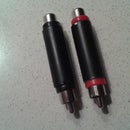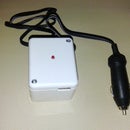Introduction: How to Make Blinking BP Christmas Lights
With this new project the idea is to turn "normal" Christmas lights into blinking ones.
I applied this specifically to LED lights, therefore I must say this Instructable is not compatible with small tungsten bulbs.
Step 1: A Simple Basic Concept
I made this project many months ago but I decided to refresh it now, right for the incoming event..
This job is based on the well-known NE555 timer, being this chip much versatile and suitable for operating with LED circuits.
The principle of the circuit is the use of the NE555 as oscillator, in the form of astable multivibrator, which provides to generate square waves at the ouput.
The oscillator alone, when working with LED circuits, can hold only few ones (I need to remember that the chip can bear a load current of up to a maximum of 200mA) so it is necessary to use a suitable transistor to "sink" or "source" a load like can be some dozens of LEDs.
I will explain later that in detail...
Step 2: What Is Needed to Get Started
Few components are needed to build this project, also readily available and cheap...
First of all, the NE555 (mine was NE555P both also with other initials is good).
three resistors 1K, 1/4 watt
one 330K resistor, 1/4 watt
one 5.6R resistor, 1/4 watt (this value is for 40 LEDs and may vary depending upon their number, so it must be calculated case by case)
one 100K (linear) potentiometer
one zener diode, rated for 5.1 volt (possibly 1W but it's OK also 1/2 W)
one electrolitic capacitor, 22 uF (25 V)
one electrolitic capacitor, 470 uF (16 V)
one ceramic capacitor, 100 nF (for pin5, this is optional)
One NPN transistor, like BC337, having at least an Ic=800 mA (this value anyway is sized for a forties LEDs drawing about 15 mA of current each)
one enclosure box for electronics (in plastic, better if with battery holder)
one Mini SPDT Slide Switch
three AAA batteries, 1.5 V
Some electrical wires (of proper size and it's better, different colors), soldering iron,tin solder
A piece of etched PCB board, where components are mounted
Step 3: The Way the Circuit Works
Previously I said that the NE555 was in the configuration of an astable multivibrator.
I must remember that the IC essentially is composed by an SR "flip flop", two comparators and a discharge transistor, T.
Sintetically, it works like this:
Considering the "flip flop" initially cleared, at the begin T is OFF and also Q=0.
When the power is switched on, the capacitor C1 starts charging through different resistors (pin6-7 and 7-8) towards Vcc, according with the time constant, t.
Once C1 voltage exceeds 2/3 Vcc the comparator 1 will be high, and S=1, R=0, Q=1 and Vout=0. This change in Q will turn T to ON condition.
C1 will now turn over to the discharging mode, according with the new time constant, t'.
When the capacitor voltage becomes lower than 1/3 Vcc, then at that moment comparator 2 will be high. As a result, S=0, R=1, Q=0 and Vout=1. T will now turn ON and the next cycle of operation will begin.
For the 555 IC to operate as an astable multivibrator it is necessary to continuously "retrigger" the 555 IC after each and every cycle. This retriggering is achieved by connecting the pin2 and the pin6 together.
Apart from the internal configuration of NE555, I forgot to say that another goal for me was to try to make pulsing "somehow" LED lights, as well as blinking.
To obtain this it is necessary to add an electrolitic capacitor just after the output of the IC (see IMAGE 1), and it has to be of some hundred of microfarads. In some way, also with the help of a diode (Zener) in parallel to R2 as shown in the diagram, it "smoothes" the signal of the square wave, then creating the effect of a "flashed" pulsation by LEDs.
Furthermore, I have made it possible to vary the "pulsation" time by LEDs inserting a 100K-potentiometer, between pin6 and pin7 of the IC.
Step 4: The Final Appearence of the Box....
As you can see from the pictures, I have fitted the circuit to the size of the enclosure box, and put a screw to fasten the PCB board at the base of the box.
Moreover, I left some space in order to insert the three batteries, in such a way as to minimize the spaces and make everything compact.
Finally, I inserted the 100K-potentiometer to the shorter side, so as to be easily accessible.
Through the pot it is possible to regulate the blinking "flashes" of the LEDs from few hundred ms to more than 1 s, however, taking into consideration the time in which the LEDs remain off is from about 2 to 4 times longer than when they are turned on.
As for the duration of the batteries, I didn't tested yet but I presume they can run all day long, or more.
So to conclude...maybe, the box was not the most suitable (it would be better to have a housing for the batteries separately), anyway I can consider myself satisfied from result...













